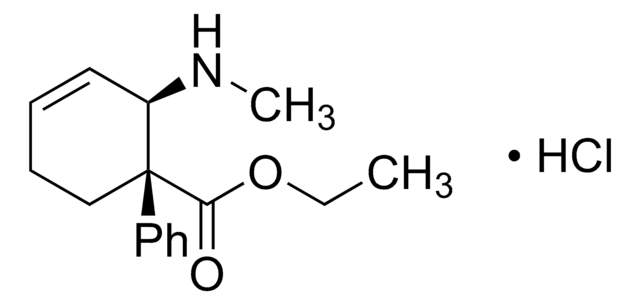Kluczowe dokumenty
E5264
2-Ethylidene-1,5-dimethyl-3,3-diphenylpyrrolidine perchlorate
analytical standard, for drug analysis
About This Item
Polecane produkty
klasa czystości
analytical standard, for drug analysis
Poziom jakości
kontrola substancji
regulated under CDSA - not available from Sigma-Aldrich Canada
metody
HPLC: suitable
gas chromatography (GC): suitable
Zastosowanie
forensics and toxicology
veterinary
format
neat
temp. przechowywania
2-8°C
ciąg SMILES
OCl(=O)(=O)=O.C\C=C1/N(C)C(C)CC1(c2ccccc2)c3ccccc3
InChI
1S/C20H23N.ClHO4/c1-4-19-20(15-16(2)21(19)3,17-11-7-5-8-12-17)18-13-9-6-10-14-18;2-1(3,4)5/h4-14,16H,15H2,1-3H3;(H,2,3,4,5)/b19-4-;
Klucz InChI
CBNJWAYHGKHAFJ-YOJQKEKBSA-N
Opis ogólny
Zastosowanie
Kod klasy składowania
11 - Combustible Solids
Klasa zagrożenia wodnego (WGK)
WGK 3
Temperatura zapłonu (°F)
Not applicable
Temperatura zapłonu (°C)
Not applicable
Środki ochrony indywidualnej
Eyeshields, Gloves, type N95 (US)
Certyfikaty analizy (CoA)
Poszukaj Certyfikaty analizy (CoA), wpisując numer partii/serii produktów. Numery serii i partii można znaleźć na etykiecie produktu po słowach „seria” lub „partia”.
Masz już ten produkt?
Dokumenty związane z niedawno zakupionymi produktami zostały zamieszczone w Bibliotece dokumentów.
Nasz zespół naukowców ma doświadczenie we wszystkich obszarach badań, w tym w naukach przyrodniczych, materiałoznawstwie, syntezie chemicznej, chromatografii, analityce i wielu innych dziedzinach.
Skontaktuj się z zespołem ds. pomocy technicznej